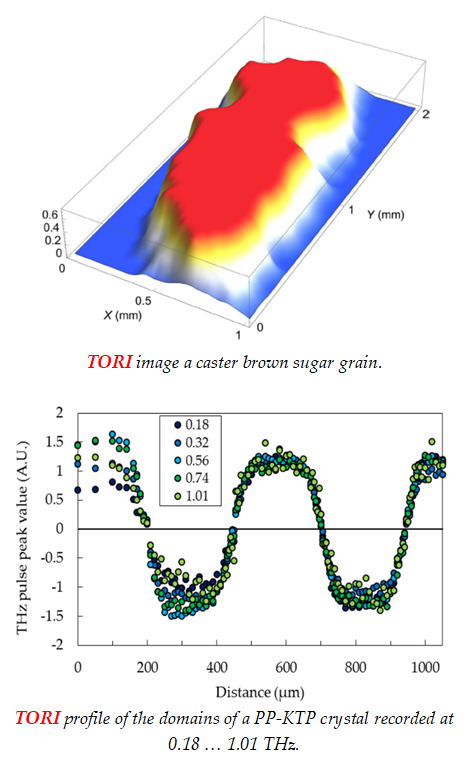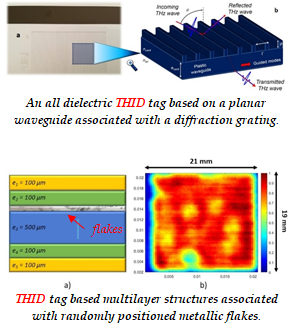Contact:
CROMA is the French pioneer laboratory in the field of THz optoelectronics since it was the first laboratory to have a time domain THz spectroscopy bench in 1995. Research activities in this field focus both on the modelling of ultra-fast photo-switches, which are the most efficient transmitting and receiving antennas for THz spectroscopy, and on the design, manufacture and characterization of new devices.
THz time domain spectroscopy is based on the optoelectronic conversion of a femtosecond laser pulse into a THz pulse by suppression of the optical carrier. The THz pulses obtained by this method have a spectrum that typically ranges from 50 GHz to 5 THz, i.e. over two decades!
THz spectroscopy is of great interest in the identification of biological molecules, for example, because of the unique THz spectral signature of the soft vibration modes of large molecules.
This axis is based on two strong and historical competence centres of the team in the THz domain: the generation and measurement of THz signals by optoelectronic channels and the characterization of materials and devices by THz-TDS, as well as a more recent activity on the functionalization of devices, initiated during the previous five years. The objective is to be able to continue to develop and propose effective characterization tools adapted to each problem, by working not only directly at the level of the THz signal source/detector, the characterization experiment, but also on the analysis and processing methods of the measured signals.
Three activities are developed within the axis : :
Exemples
- Sub-wavelength imaging in the THz domain
- Authentication of products in the THz domain
Sub-wavelength imaging in the THz domain by means of nonlinear optical rectification
We are developing an original technique, namely THz Optical Rectification Imaging (TORI), to obtain the THz signature of a sample with a sub-wavelength lateral resolution. The basic idea is to generate a THz beam through optical rectification at the surface of a sample. The lateral resolution is limited by the laser spot size and not by diffraction at THz wavelengths. The image, achieved by scanning the laser beam over the sample, reveals the crystallinity and composition of the heterogeneous sample. The outmost limit of the technique is given by the optical damage threshold of the sample and the sensitivity of the THz detector. Presently, a /206 resolution has been achieved at 140 GHz. This technique is complementary to SHG and THG imaging, widely used in biology/medicine, because the linear and nonlinear optical properties of matter are different in the visible and THz.
Study performed by: Gizem Soylu (PhD student), Federico SanJuan* (post-doc), Gwenaël Gaborit, Emilie Hérault and Jean-Louis Coutaz* presently IGR CNRS, LFCR, University of Pau, France
Collaborations (PP-KTP):
- F. Laurell, KTH, Stockholm, Sweden
- B. Boulanger, Néel Institute, Grenoble, France
- Emilie Hérault, herault@univ-smb.fr
- Gwenaël Gaborit, gaborit@univ-smb.fr
- Jean-Louis Coutaz, coutaz@univ-smb.fr
Authentication of products in the THz domain
We are developing THz IDentification tags (THID) to identicate and/or authenticate products using THz waves. The principle is 1) to design a structure exhibit a rich enough THz signature and 2) to use randomness phenomena to make this signature unique. We first propose 2 solutions:
- One based on a planar waveguide associated with a diffraction grating to obtain a spectral response très “chahutée”????, in order to use a broadband signature (typically from 200 to 800 GHz) and using statistical analysis (Principal Component Analysis, Linear Discriminant Analysis…).
- A second one dedicated to 2D THz imaging using metallic flakes embedded in a multilayer dielectric “sandwich” using image analysis method (2D correlation coefficient Shape or Invariant Wavelet Packet Decomposition).
The randomness is then obtained by the fabrication uncertainties of the grooves and the position of the flakes respectively. We obtain, for the first type of tag, a correct classification rate as high as 99.994% on a set of 4400 measurements made on 44 tags “identical” fabricated with the same pattern.
Study performed by: Florent Bonnefoy (post-doc), Maxime Bernier and Frederic GaretCollaborations:
- C. Ioana, GIPSA Lab, Grenoble, France
- S. Girard, INRIA, Grenoble, France
- Maxime Bernier, bernier@univ-smb.fr
- Frédéric.garet, garet@univ-smb.fr





